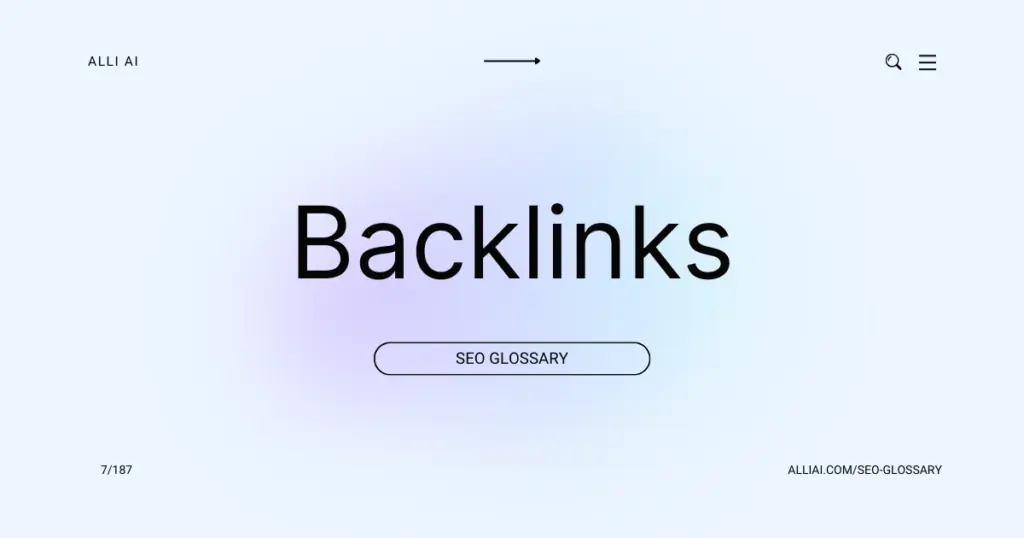What Does Backlinks Mean?
Backlinks are links from one website to a page on another website. They are also known as “inbound links” or “incoming links.” Backlinks are important for SEO because they signal to search engines that others vouch for your content. If many sites link to the same webpage or website, search engines can infer that content is worth linking to, and therefore also worth surfacing on a SERP. So, earning these backlinks can have a positive effect on a site’s ranking position or search visibility.
Where Does Backlinks Fit Into The Broader SEO Landscape?
Backlinks are integral to the domain of SEO as they significantly impact a website’s rank and credibility. They are links from one website to a page on another website, and Google’s algorithms use them as indicators of the content’s quality and relevance. A site with many high-quality backlinks will generally rank better than similar sites with fewer backlinks. In the broader SEO context, backlinks serve three main roles:
1. Ranking Improvement: Search engines consider backlinks as votes of confidence. The premise is that if a website links to another site, the linking site finds the content valuable and of high quality. This endorsement helps improve the linked site’s visibility and ranking on search engine results pages (SERPs).
2. Discoverability: Search engines like Google use bots to crawl the web. Backlinks from frequently visited websites can help these bots discover and index your content faster, especially if your site is new or has few external links.
3. Referral Traffic: Besides the SEO benefits, backlinks can directly bring users from another website via the link. This referral can increase overall traffic to a site, which can indirectly boost SEO as it signals popularity and relevance to search engines.
In the broader SEO strategy, maintaining a healthy backlink profile is crucial. This involves acquiring high-quality backlinks from reputable sites and managing and removing any poor-quality or spammy backlinks that might harm a site’s ranking.
Real Life Analogies or Metaphors to Explain Backlinks
1. Backlinks are like votes of confidence. Imagine every link to your website as a vote in an election. The more votes (backlinks) you have, the more trustworthy and valued your site appears, much like a political candidate who’s supported by many people.
2. Backlinks as invitations to a party. Each backlink is an invitation from one website to another, encouraging visitors to attend a new and interesting event (your website). The more high-quality invitations you have, the better the party is expected to be.
3. Backlinks are like bridges. They connect two separate locations (websites) over the internet, allowing visitors to easily travel between them. The stronger and more numerous these bridges, the more traffic can flow directly to your site.
4. Backlinks as academic citations. In academic writing, a paper is often judged by the number of citations it receives. Similarly, a website with many backlinks is seen as more authoritative, as each backlink serves as a nod from another site indicating the quality or usefulness of your content.
5. Backlinks as referrals. Think of each backlink as a personal recommendation a friend might make about a restaurant. The more recommendations (or backlinks) your website has from reputable sources, the more likely new visitors are to check it out, trusting the endorsements made by others.
How the Backlinks Functions or is Implemented?
1. Identification of Link Targets: Identify websites that are relevant to your website’s content and have a high domain authority.
2. Content Creation: Develop valuable, high-quality content that is likely to attract backlinks, such as blog posts, infographics, and videos.
3. Outreach: Contact website owners, bloggers, and influencers to introduce your content and suggest that it could add value to their existing content.
4. Link Placement: The website owner places a hyperlink in their content that points to your website. This link can be placed within the body of an article, in a resource list, or as a part of a product review.
5. Link Type: The link should ideally be a “dofollow” link, allowing search engines to follow and pass on link equity to your site.
6. Monitoring: Use tools to track the backlinks and assess the value they add in terms of referral traffic and SEO improvement.
7. Maintenance: Regularly check if the backlinks are still active and if the linking websites maintain their credibility and authority. Remove or disavow links from low-quality or spammy sites.
8. Feedback and Adjustment: Analyze the performance of your backlink strategy and refine your approach based on what types or sources of backlinks deliver the most beneficial results.
Impact Backlinks has on SEO
Backlinks significantly impact a website’s SEO performance by serving as a key ranking signal for search engines like Google. High-quality backlinks from reputable, relevant sites indicate to search engines that the content on your website is valuable and trustworthy, which can lead to higher search engine rankings. Consequently, this improves the website’s visibility and organic traffic. Additionally, backlinks can enhance user experience by linking users to additional relevant information, thus providing a more comprehensive resource. However, poor-quality backlinks, such as those from spammy or irrelevant sites, can negatively affect SEO performance, potentially leading to penalties from search engines.
SEO Best Practices For Backlinks
1. Identify High-Quality Sites: Research and compile a list of authoritative websites related to your niche.
2. Analyze Competitor Links: Use tools like Ahrefs, SEMrush, or Moz to analyze the backlink profiles of your competitors and identify potential backlink opportunities.
3. Create Valuable Content: Develop high-quality, unique, and informative content that naturally attracts backlinks.
4. Guest Blogging: Reach out to websites from your compiled list and offer to write a guest post with a link back to your site.
5. Broken Link Building: Find broken links on relevant websites using tools like Check My Links, and suggest your content as a replacement.
6. Use Infographics: Design and share compelling infographics and reach out to websites that might be interested in featuring it.
7. Participate in Industry Forums and Commenting: Become active in online communities and forums related to your niche, providing helpful answers and including relevant links back to your content.
8. Social Media Sharing: Promote your content on social media platforms to increase visibility and potential for backlinks.
9. Utilize Influencer Outreach: Connect with influencers in your niche and ask them to share your content or collaborate on content that includes a backlink.
10. Monitor Your Backlinks: Regularly check your existing backlinks using tools like Google Search Console and ensure they remain active and beneficial.
These steps form a comprehensive approach for an effective backlink strategy that can improve your website’s SEO.
Common Mistakes To Avoid
1. Low-Quality Links: Avoid links from spammy or irrelevant sites as they can harm your site’s credibility and SEO ranking.
2. Buying Backlinks: This practice is against Google’s guidelines. Acquiring paid links can lead to penalties or a drop in search rankings.
3. Excessive Link Exchange: Exchanging too many links with other sites can be seen as manipulative by search engines and negatively impact your SEO.
4. Irrelevant Links: Backlinks from sites that have no relevance to your content can dilute your website’s thematic relevance.
5. Using Only Exact Match Anchor Text: Overuse of keyword-rich anchor text can appear unnatural and get flagged by search engines as spammy behavior.
6. Ignoring Nofollow Links: Not all backlinks need to be followed; nofollow links from high-quality sites are beneficial for driving traffic and can indirectly improve SEO.
7. Neglecting Internal Links: Focusing solely on external links while ignoring internal linking opportunities can limit site navigation and user experience, impacting SEO.
8. Overlooking Link Quality Over Quantity: Prioritize high-quality links from authoritative sites rather than amassing a large number of poor-quality links.
9. Failing to Monitor and Remove Bad Links: Regularly audit your link profile to identify and disavow toxic backlinks that could harm your site’s ranking.
10. Not Diversifying Backlink Sources: Relying on a single source or type of backlink can make your SEO strategy vulnerable if that source loses credibility or changes its linking policy.






